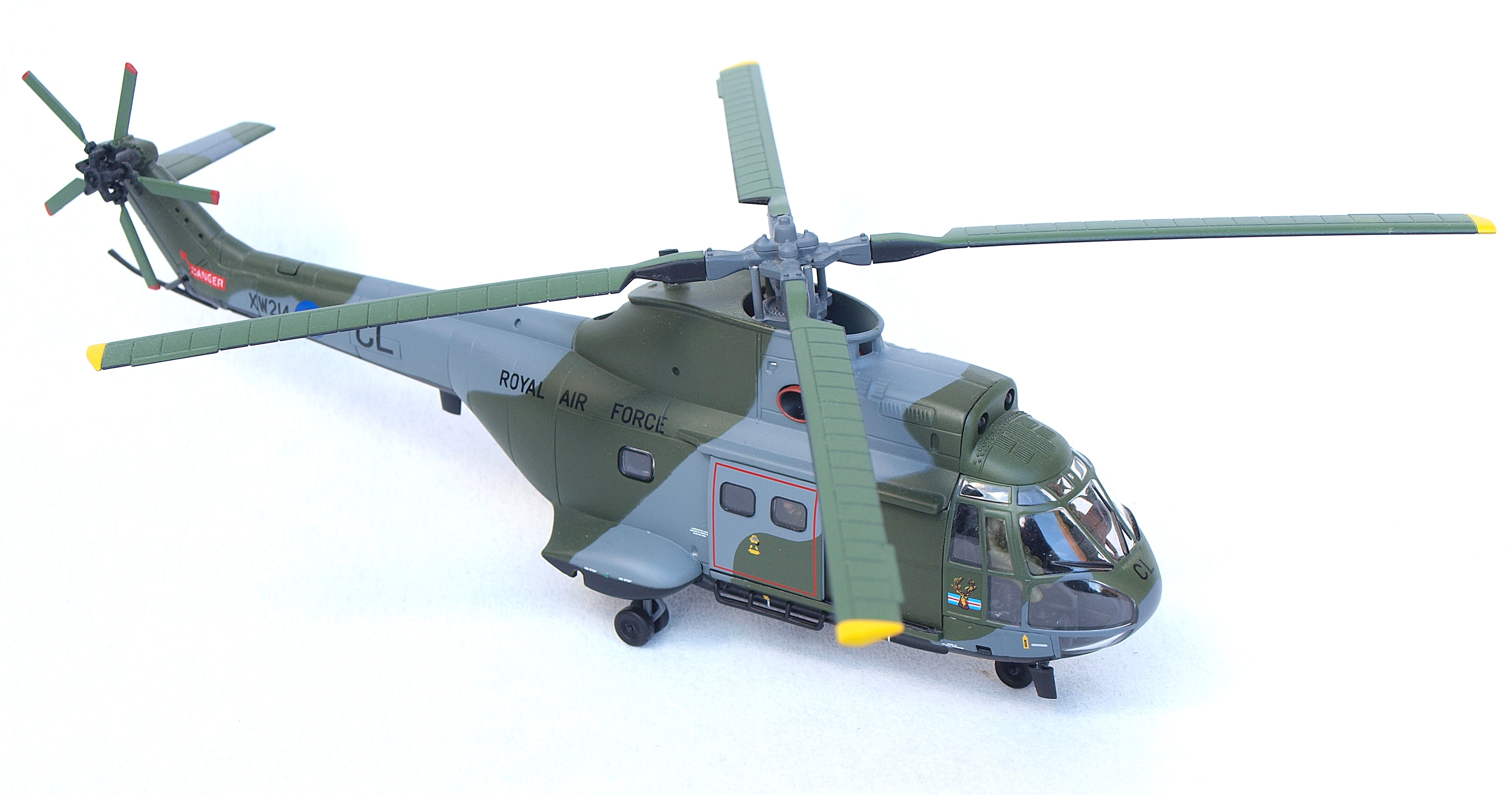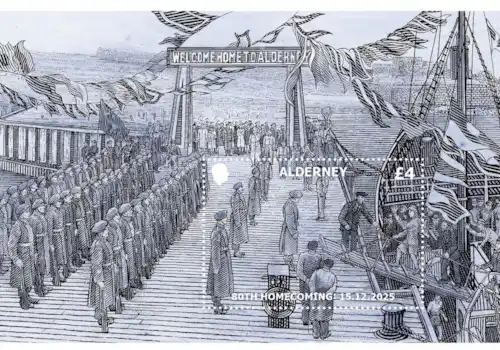29 May 2025
|
After more than 50 years in service, in March this year, the RAF retired the last of its Puma helicopters.
To commemorate the occasion, Jarrod Cotter examines Corgi’s 1:72 scale model of the Puma HC.1, a must-have for collectors.
When was the last Puma helicopter flight?
On 26/27 March 2025 personnel at RAF Benson waved off Puma helicopters for the last time as they embarked on their farewell flights in a series of flypasts around the UK.
What Makes the Corgi Puma HC.1 Model Stand Out?
The Corgi model of the Puma HC.1 is very pleasant and well detailed. It features numerous aerials and rails, rotating rotor blades, sliding doors, underside shackle for loads, optional undercarriage up or down and three crew figures, two pilots and a loadmaster. The paintwork is nicely applied and the printing neat.
How Many Corgi Puma Models Have Been Released?
Five models are known to have been released to date.

Corgi Puma Model Reviews
AA27001 represents XW219 of 230 Squadron, RAF Benson, circa November 2009. It is painted in an all-over green with modern RAF branding on the doors and a 230 Squadron tiger badge on its forward fuselage.
AA27002 models XW214/CL of 33 Squadron, RAF Aldergrove, Northern Ireland, circa November 1972. It is painted in grey/green camouflage on its topsides with black undersides. There is a 33 Squadron stag’s head badge on the forward fuselage. Note that this model features the early style of engine air intakes.
AA27003 represents XW224 of 230 Squadron as it was at the Tiger Meet, RAF Upper Heyford, in 1990. It has a black forward fuselage with a large tiger painted all along the rear fuselage. The paintwork on this model is particularly impressive.
AA27004 models XW220/CZ of 33 Squadron as it was during the First Gulf War of 1991, when it was based in Kuwait. This model is painted in desert ‘pink’ with a 33 Squadron stag’s head badge on its forward fuselage.
Finally, AA27005 represents XW220/AC of 72 Squadron, RAF Aldergrove, Northern Ireland, circa 1997. This example features black/green wrap-round camouflage with a 72 Squadron swift badge on its forward fuselage.
What Is the RAF Puma Helicopter and Why Is It Important?
The Puma is a twin-engined medium helicopter and has been a workhorse of the Royal Air Force (RAF) for over five decades, having been introduced into service in 1971.
What Roles Has the Puma Played in RAF Service Since 1971?
The Puma quickly became a key asset, known for its agility, speed, and versatility. Over the years, it has been deployed in numerous operations and humanitarian missions around the world.
Where Has the RAF Puma Been Deployed in Recent Years?
In recent history it has seen service in Kenya from 2009 to 2011 where these helicopters supported UK exercises and in Afghanistan from 2015 to 2021.
It has also provided support in the Caribbean as a part of Operation Ruman after Hurricane Irma in September 2017. Right up until its end in RAF service, the Puma has been involved in enduring operations in Cyprus and Brunei.
What Are the Capabilities of the Puma HC.1 and HC.2?
The Puma HC.1 was a sound, reliable helicopter with a spacious main cabin. It could carry up 16 fully equipped troops or 20 unencumbered passengers. In the aeromedical role it could carry up to six stretchers and six seated casualties.
While some supplies could be carried in the cabin, bulky loads such a 105mm Light Gun would be slung underneath the fuselage.
What Are the Primary Roles of the RAF Puma?
Since 1971 the Puma has been a versatile and reliable asset for the RAF.
How Has the Puma Supported Battlefield and Freight Operations?
In that time, it has been utilised as a battlefield aircraft (both in times of conflict and for peacekeeping), a Search and Rescue (SAR) asset, it has provided Military Aid to the Civil Authority (MACA), including firefighting and has been deployed as a humanitarian aid for disaster relief.
The primary role of the Puma was as a battlefield-focussed support helicopter. The main use case of such an asset was the tactical deployment and recovery of troops.
How Has the Puma Supported Battlefield and Freight Operations?
The later Puma Mk.2 could carry up to 16 passengers or 12 fully equipped troops and could defend itself when fitted with two 7.62mm General Purpose Machine Guns.
While not as large as a Chinook, the Puma was perfectly equipped for the management of smaller or more specialist infantry troops, with the ability to land in tighter confined areas with a smaller noise footprint and fewer issues arising from downwash.
The Puma has been used extensively in this capacity across its entire service life.
The other component of support helicopter operations is the carriage of freight, either internally, underslung or a combination of both. It is hard to state exact performance and capability for a support helicopter, because many factors affect the equation as it’s a sliding scale of weight and range.
However, we can say that a Puma could reliably deliver a car sized object 100 nautical miles away in an hour. The Puma has been continuously used to transport supplies, ammunition, and equipment to remote and challenging locations around the globe, ensuring that troops have the resources they need to complete their missions.
How Is the Puma Used in Medical Evacuation and Search and Rescue (SAR)?
As previously mentioned the Puma can be fitted with up to six stretchers, allowing it to transport injured personnel from the front lines to medical facilities. This capability has been vital in saving lives during combat operations and humanitarian missions. When fitted with a rescue hoist the Puma could perform SAR duties as it has done in Cyprus since replacing the Griffin HAR.2 in 2023.
While primarily focussed on the recovery of fast jet aircrew following ejections, the Puma has performed dozens of SAR operations for the civilian and military population of Cyprus.
The Puma has been deployed in numerous humanitarian and disaster relief operations. It was unique in the RAF’s fleet, in its ability to be deployed inside a C-17 Globemaster.
Two Pumas could be flown to RAF Brize Norton, stripped and loaded in just 4 hours. The C-17 would then transit anywhere around the world and deploy the two Pumas which could be rebuilt and airborne 4 hours after the C-17 touched down.
This and its ability to operate in harsh environments has made it invaluable in responding to natural disasters and providing assistance to affected populations.
What Are the Key Deployments of the RAF Puma?
The Puma was extensively used during the conflict in Northern Ireland, this being the first operational employment of the type, providing mobility and support for British forces.
During the conflicts in the Balkans, the Puma was deployed to support NATO operations, transporting troops and supplies and conducting medical evacuation missions.
The helicopter saw significant action in Iraq and Afghanistan, where it was used for troop transport, medical evacuation and logistical support. During Operation Toral in Afghanistan, the Puma flew 12,800 hours, transported 126,000 passengers, and moved 660,000kg of freight.
What Happened During the Puma’s Farewell Flights?
The Puma’s final flights were organised to honour its remarkable service. “This flight route is via various locations of significance,” explains Wing Commander Nick Monahan, Officer Commanding 33 Squadron and Puma Force Commander. “Each place reflects the rich history and contributions that the Puma has made during its time in service.
The aircraft has been a cornerstone of global defence operations for more than five decades. We want to celebrate its contribution to supporting our people around the world over the past 54 years. We recognise and celebrate the dedication of everyone who has served on or supported Puma operations over the last five decades,” said Wing Commander Alice Tierney, Station Commander at RAF Benson.
What Will Replace the RAF Puma Helicopter?
In the longer term a new medium helicopter will be designed to replace the Puma’s capability of medium lift to land forces. The contract for this is still in the negotiations phase.
If you enjoy toy collecting, collectors can get the latest collecting news by signing up for the Collectors Club of Great Britain’s newsletter.







